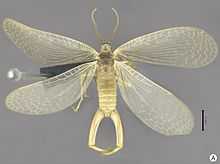Meropeidae
Meropeidae
Temporal range: Triassic to Recent220–0Ma |
| |
| Merope tuber |
|
Scientific classification  |
| Kingdom: | Animalia |
| Phylum: | Arthropoda |
| Class: | Insecta |
| Order: | Mecoptera |
| Family: | Meropeidae |
|
| Genera |
- Austromerope Killington, 1933 (Australia, Brazil)
- †Boreomerope Novokschonov, 1995 (Siberia; extinct)
- Merope Newman, 1838 (USA, Canada)
- †Thaumatomerope Rasnitsyn, 1974 (Kyrgyzstan; extinct)
|
The Meropeidae are a tiny family of the order Mecoptera with only three living species, commonly referred to as "earwigflies" (or sometimes "forcepflies"). They are: the North American Merope tuber, the Western Australian Austromerope poultoni, and the newly discovered South American Austromerope brasiliensis.[1] The biology of these species is essentially unknown, and their larvae have never been seen. [2] The disjunct distribution suggests a common origin before the breakup of the ancient supercontinent of Pangaea. There are two extinct genera, Boreomerope antiqua Novokschonov from the Middle Jurassic of Siberia and Thaumatomerope with three described species all from the Madygen Formation in Kyrgyzstan; as such, the extant members of this family can be considered living fossils. These insects are also of interest due to their presumed basal position in the order Mecoptera.
References
- Wills, Allan (2007). "Earwig Flies? Ancient and Mysterious Insects". Western Wildlife 12 (1): 5.
|
|---|
| | | | Clade 1 | |
|---|
| | Clade 2 | | | | Pulicomorpha | Pulicoidea | |
|---|
| Ancistropsylloidea | |
|---|
| Coptopsylloidea | |
|---|
| Malacopsylloidea |
- Malacopsyllidae
- Rhopalopsyllidae
|
|---|
| Vermipsylloidea | |
|---|
|
|---|
| Ceratophyllomorpha | |
|---|
| Hystrichopsyllomorpha | | |
|---|
| Hystrichopsylloidea |
- Chimaeropsyllidae
- Hystrichopsyllidae
|
|---|
| Macropsylloidea | |
|---|
|
|---|
| Pygiopsyllomorpha | Pygiopsylloidea |
- Lycopsyllidae
- Pygiopsyllidae
- Stivaliidae
|
|---|
|
|---|
|
|---|
|
|---|
| |
|
 |
Wikimedia Commons has media related to Meropeidae. |
